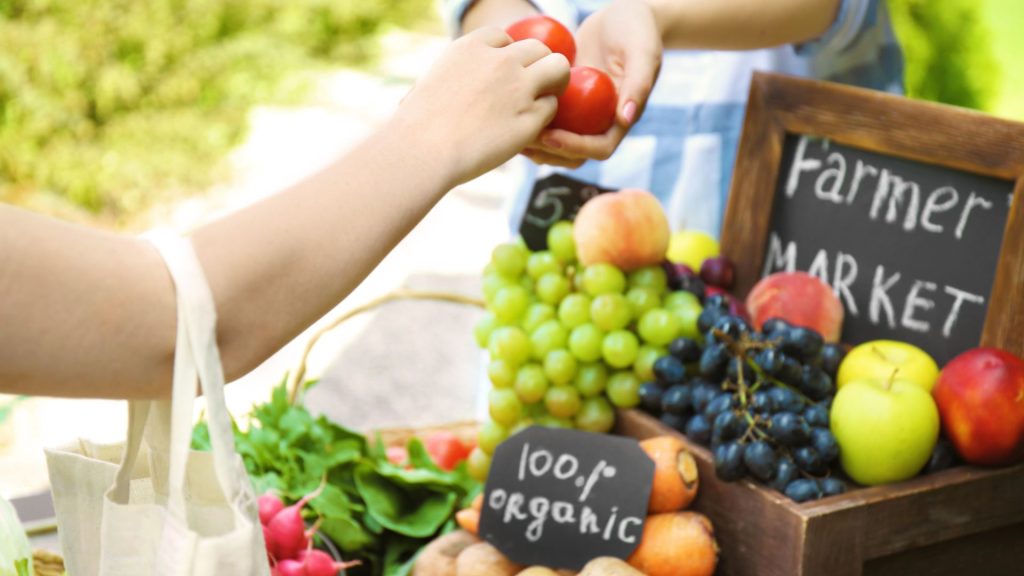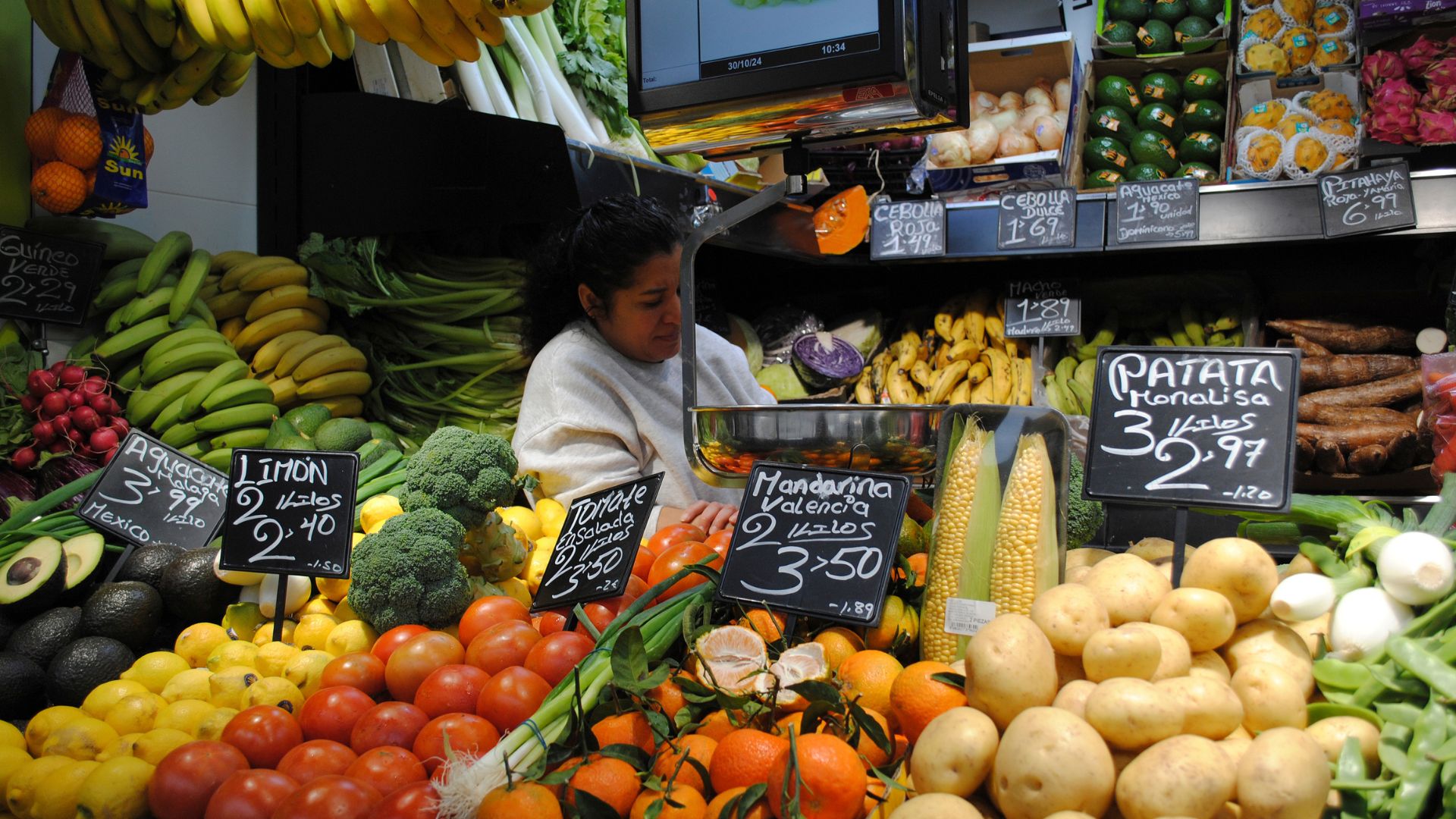
Seville’s Food Markets: A Living Tradition of Taste and Community
Markets as the Heart of the City
In Seville, food markets are more than places to buy ingredients — they are part of the city’s social architecture. Every neighborhood has one, and each tells a story about how people live, eat, and connect. These spaces are not crafted for tourists or special occasions; they are where daily life unfolds.
Rooted in centuries of tradition, many of Seville’s markets were established during times of urban reform in the 19th century, replacing outdoor stalls and chaotic trading areas with organized, hygienic municipal buildings. Today, these markets remain essential — not just for their fresh products, but for their role in maintaining community rhythm, conversation, and continuity.
A walk through any of these markets reveals what Seville values: local ingredients, trusted relationships, and the small rituals of everyday life.
“To understand a culture, taste its food.”
Why go to a food market ? And what is it like
Visiting a local food market in Seville offers much more than the chance to see what’s on the menu. It provides a real connection to the city’s daily life, history, and culinary values. So many markets has been a shared space between tourists and locals. The stalls offer excellent quality of fresh and local food and even small stalls with samples and tastings.Here are some of the key benefits:
1. Experience Authentic Local Culture
Markets reflect the habits, tastes, and traditions of the people who live in the city. They show what’s in season, what’s valued, and how food is approached — not as a luxury, but as a part of everyday life. Observing how locals interact, shop, and eat offers a much deeper cultural insight than any monument tour.
2. Discover Regional Ingredients
From Sierra Norte cheeses and Iberian pork to locally cured olives, chickpeas, and Seville oranges, the markets are a showcase of Andalusia’s agricultural richness. Many of these ingredients never make it to supermarket shelves or restaurant menus abroad, making the market a great place to see — and sometimes taste — what locals truly eat.
3. Learn from Real People
Vendors in Seville’s markets are often second- or third-generation specialists. A butcher may have learned from his father; a spice seller might offer advice on preparing salmorejo just like her grandmother did. These brief, friendly exchanges bring local knowledge to life — especially if you speak a little Spanish (or have a guide who does).
4. Support Local Economy and Small Producers
Markets are part of a sustainable and community-based economy. Many stalls source their goods directly from nearby farms, family-owned dairies, or Andalusian co-ops. By buying here — even something small — you’re contributing to local businesses and food traditions that have been passed down for generations.
5. Taste First, Buy Later
In many markets, especially the larger ones like Triana or Encarnación, you’ll find small bars, bakeries, or tasting corners. Try a sliver of cured ham, a piece of aged cheese, or a midday tapa right on the spot — no reservations needed.
Seville’s Main Markets: A Guide
Each market reflects the identity of its neighborhood and offers a slightly different experience. Here are four of the most notable:
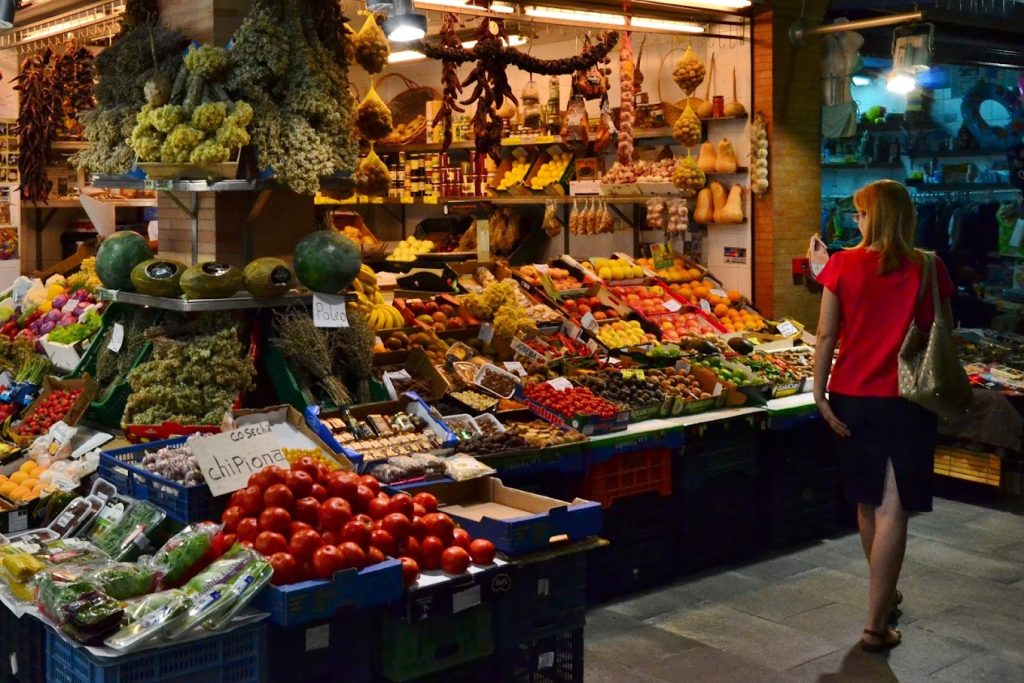
1. Mercado de Triana
📍 Plaza del Altozano, just across the Isabel II (Triana) Bridge
Mercado de Triana is one of Seville’s most well-known and active food markets — not just because of its location, but because it’s still very much part of local life. You’ll find it right at the entrance to the Triana neighborhood, built on top of the ruins of the Castle of San Jorge, which once housed the Spanish Inquisition. Today, it’s a bright, functional space where locals shop, chat, eat, and get things done.
The market itself is a 19th-century covered building that was fully renovated in the early 2000s. Inside, it’s easy to navigate: rows of clean, tiled stalls offering fresh fish, meat, fruit and vegetables, cheese, spices, and traditional sweets— most from regional producers. It’s not a tourist spectacle, and that’s what makes it worth visiting. People actually come here to do their weekly shopping, and you’ll often overhear regulars swapping recipes with their vendors.
There are also a few small tapas counters and cafés inside — ideal for a quick tostada or a glass of wine while taking in the market atmosphere.
But what makes Mercado de Triana even more interesting is what else is going on inside. Alongside the food stalls, the market also houses:
- A small cooking school, which offers Andalusian cooking workshops (especially popular in the evenings)
- A tiny neighborhood theatre, which hosts flamenco, storytelling, and small productions
- And even a shoe repair shop, quietly operating in a corner — the kind of practical service you’d expect in a market that still serves locals first
If you’re curious, you can also access the Inquisition Museum downstairs, where remains of the old castle walls are still visible. It’s a surprising historical layer just below the busy market floor.
Good to know:
- Best time to visit: weekday mornings (before 12:00) when locals are doing their shopping
- Closed on Sundays, limited hours on Saturdays
- It pairs nicely with a walk along Calle Betis or a stop at nearby ceramic workshops
Mercado de Triana isn’t huge, but it’s one of the most complete examples of a living urban market: food, history, daily life, and community all under one roof.
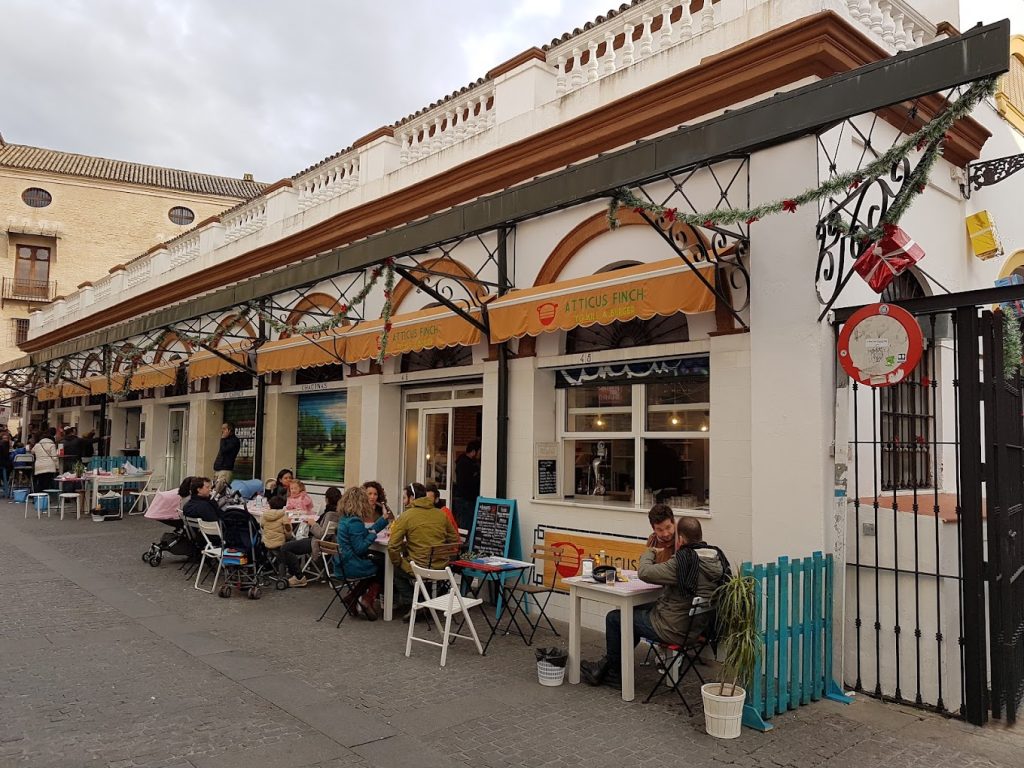
2. Mercado de Feria
📍 Calle Feria, near Omnium Sanctorum Church and Alameda de Hércules
Mercado de Feria is Seville’s oldest functioning market, and one of its most authentic. Located on historic Calle Feria, just steps from the Omnium Sanctorum Church, this market has been part of the local landscape since the 18th century. Though the current building is more recent and modernized, the market still operates on a local, neighborhood scale — compact, unpretentious, and deeply rooted in community life.
What sets Mercado de Feria apart today is its blend of traditional food stalls and casual bars, all sharing the same space. It’s not just a place to shop — it’s a place to stop, eat, and hang around. In fact, the number of tapas counters, wine bars, and prepared food stalls nearly rivals the number of produce or butcher stands. For many visitors (and locals), it’s as much about enjoying a tapa as it is about picking up groceries.
You’ll still find a solid selection of fresh vegetables, fruit, meat, fish, spices, and pickles, with vendors who have served generations of regulars. But you’ll also see people gathering at small counters for a glass of wine, grilled sardines, local cheeses, or even sushi — the market has evolved, but without losing its soul.
Why it’s worth visiting:
- It has a lively, neighborly feel — especially late morning
- The mix of traditional stalls and informal dining gives it a flexible, open rhythm
- You can shop for ingredients or just drop in for tapas and a cold beer
- It’s one of the few markets where the bar culture feels fully integrated into the space
Right next to the market is a small fish annex and a few old-school taverns, and on Thursday mornings, the surrounding streets host El Jueves, Seville’s centuries-old flea market — a unique combination of food, antiques, and local character.
Good to know:
- Best time to visit: late morning (10:30–13:00) when both stalls and bars are buzzing
- It’s a great pre-lunch stop when heading toward Alameda de Hércules or exploring the Macarena
- Closed Sundays; Saturday is busy but festive
Mercado de Feria feels like one of those places that stays true to itself, even as the city around it changes. If you’re looking for everyday Seville, with a glass of wine and a tapa on the side, this is it.
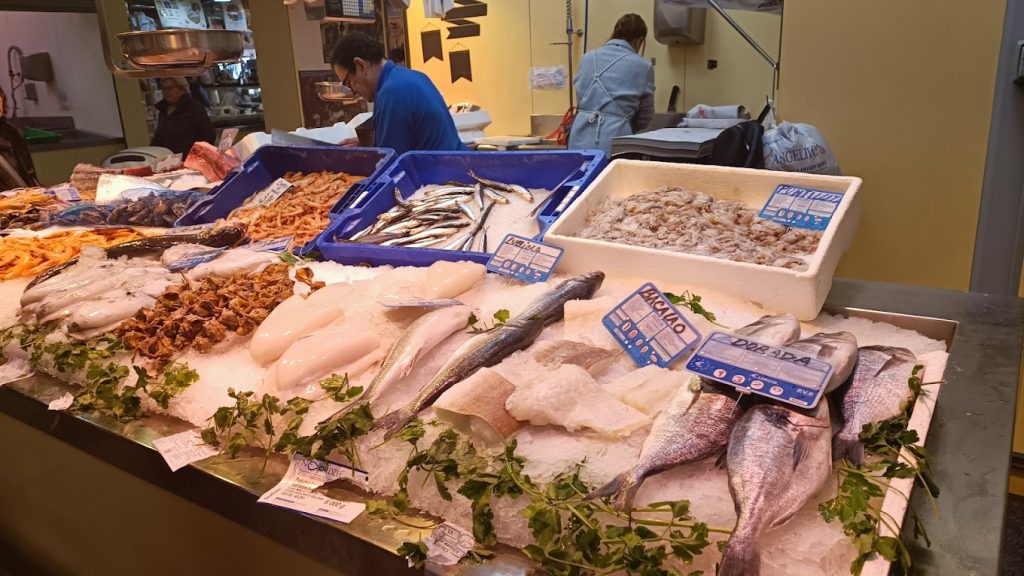
3. Mercado de la Encarnación (Setas Market)
📍 Plaza de la Encarnación, beneath the Metropol Parasol (“Las Setas”)
Mercado de la Encarnación is Seville’s most modern central market — both in architecture and feel. It sits directly beneath the striking wooden canopy of the Metropol Parasol, locally known as Las Setas (“The Mushrooms”) because of its shape. While the structure above often steals the spotlight, the market underneath is very much in operation and worth a visit on its own.
This market was built in the 2010s, replacing an older structure that had been torn down decades earlier. During the rebuilding process, Roman and Andalusí ruins were uncovered — now preserved in the Antiquarium, a museum located just below the market level. It’s one of the few places in Seville where history, food, and contemporary designcoexist under one roof.
Inside, the market feels clean, organized, and a bit more modern than others in the city. You’ll find around 25 stalls selling fresh produce, meat and poultry, fish and shellfish, olives, spices, and prepared products. Compared to Triana or Feria, the pace here is slower and more practical — it serves both nearby residents and visitors exploring the city center.
While not overflowing with tapas bars inside, there are a few options for a bite or a drink, and plenty of places to eat in the open square just outside the market.
What makes it interesting:
- A rare mix of modern design, urban function, and archaeological context
- Centrally located — ideal for combining with sightseeing or a casual lunch
- Offers a taste of the city’s evolving food culture, without losing its local roots
Good to know:
- Open Monday to Saturday, typically from 8:00 to 15:00
- Closed Sundays
- Best visited in the morning or just before lunch — the earlier the better for fresh seafood and produce
- The Antiquarium museum underneath is worth a stop if you enjoy Roman or medieval history
Mercado de la Encarnación may not have the noise and energy of older neighborhood markets, but it gives a clear picture of how Seville balances tradition with contemporary life — and where food remains at the center of it all.
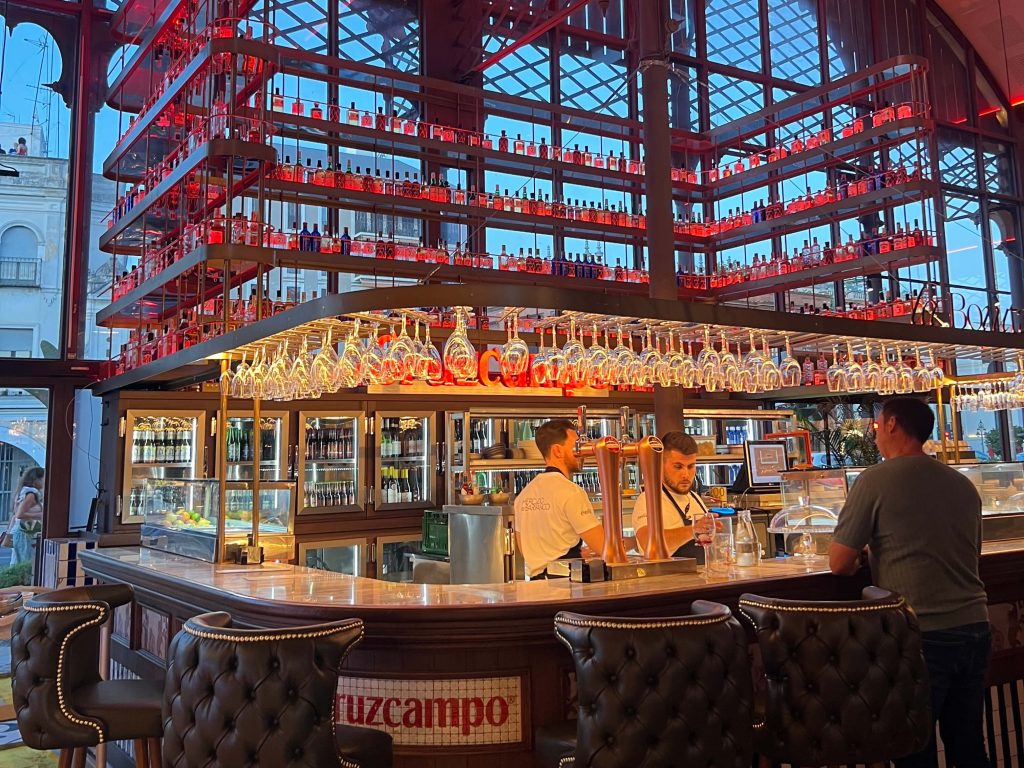
4. Lonja del Barranco
📍 Paseo de Cristóbal Colón, next to the Triana Bridge
Mercado del Barranco is quite different from the other markets listed — not a traditional neighborhood market, but a modern gourmet space in a historical setting. Housed in a beautiful 19th-century cast-iron building designed by Gustave Eiffel’s firm, it served as a wholesale fish market for over a century before being closed and later reimagined.
In 2014, it reopened as a gastronomic market, offering small food stands, shared seating areas, and river views — part food court, part wine bar, part cultural venue. Unlike markets like Feria or Triana, there are no raw meat or vegetable vendors here; it’s purely a place to eat, drink, and socialize.
The space includes more than 20 small stalls offering everything from salmorejo and Andalusian stews to sushi, mini burgers, croquetas, grilled seafood, wine, and cocktails. It’s designed for informal, flexible dining — you grab what you like from different counters, then find a spot at the communal tables, indoors or on the riverside terrace.
Because of its central location — right by the Triana Bridge and facing the Guadalquivir River — it tends to attract a mixed crowd: tourists, local office workers on lunch break, and Sevillanos meeting friends for drinks in the evening. It’s especially lively on weekends.
What makes it unique:
- A beautifully restored iron structure with historical significance
- No raw food shopping — it’s all about prepared food and drink
- Great location for a riverside lunch or a casual dinner after a walking tour
Good to know:
- Open every day, typically from noon to midnight (longer hours on weekends)
- Best for tasting a wide variety of modern Andalusian bites in one place
- Can get crowded during lunch and dinner, especially on Fridays and Saturdays
Mercado del Barranco isn’t where Sevillanos do their shopping — it’s where they go to relax, snack, and enjoy a drinkin one of the city’s most scenic spots. Think of it as the final stop on a market journey: the one that’s made for sitting down and savoring it all.

5. Mercado Puerta de la Carne
📍 Avenida Ramón y Cajal, near Prado de San Sebastián
Tucked into a residential area just southeast of the city center, Mercado de la Carne is one of Seville’s quieter, more functional local markets. The name (“Meat Market”) reflects its original purpose, though today it offers a full range of products beyond meat.
The market was built in the mid-20th century and serves the surrounding neighborhoods of Nervión and El Porvenir, making it popular with families and older residents who prefer smaller-scale, personal shopping to larger supermarkets. Though compact, the market has undergone renovations in recent years and now includes modern lighting, updated stalls, and cleaner infrastructure, while still maintaining its everyday, no-frills charm.
Inside, you’ll find a solid variety of vendors offering fresh produce, meat and poultry, fish, cured products, spices, and bakery goods. Like other traditional markets, many stalls are run by long-established vendors who have built loyal relationships with their customers.
One notable addition in recent years is the gastro-space: a section of the market adapted for casual eating and small events. It includes tapas stalls and communal tables, where locals gather for lunch, drinks, or weekend meetups. While smaller than Triana or Feria, this setup reflects the city’s growing blend of tradition and modern food culture.
Good to know:
- Open Monday to Saturday, typically until 15:00
- Best time to visit: morning to midday, especially Friday or Saturday when there’s more energy
- Easily combined with a walk to Prado de San Sebastián or Parque de María Luisa
Mercado de la Carne may not be historic or central, but it’s a good example of how Seville’s local markets are adapting to changing times — still rooted in fresh food and daily life, but welcoming new ways of enjoying it.

6. Mercado de los Remedios
📍 Calle Pedro Pérez Fernández, Los Remedios neighborhood
Mercado de Los Remedios is a classic neighborhood market in a residential area just southwest of the historic center — a short walk or metro ride from Triana. It’s not on most tourists’ radar, and that’s exactly what makes it valuable: this is a place where Seville shops for real.
The market opened in the mid-20th century as the Los Remedios district grew into a modern residential area, especially during the 1960s and ’70s. Today, it remains a key part of daily life for locals — clean, well-maintained, and full of longtime vendors who serve regular customers.
Inside, you’ll find a typical layout: rows of meat, fish, produce, and charcuterie stalls, many of them family-run. The market isn’t large, but it’s efficient and calm — no tourist crowds, just locals buying ingredients for the day. There’s a slightly more spacious feel compared to older, tighter markets like Feria.
What makes this market worth noting is its consistency and local character. The quality of the food is high, and many residents consider it one of the best markets in terms of value for money.
It’s also surrounded by local cafés and bakeries, so it’s easy to make a relaxed morning of it.
Good to know:
- Best time to go: weekday mornings, especially before lunch
- Open Monday to Saturday, typically until 15:00
- Near Parque de los Príncipes and a short walk from the Guadalquivir River
Mercado de Los Remedios won’t appear on most guidebooks — but if you want to see what Seville looks like beyond the monuments, this market offers a very honest, local view.
Markets as a Cultural Experience
To visit one of Seville’s food markets is not just to see how the city eats — but how it lives. These spaces are about rhythm, tradition, and trust. They’re not curated experiences, but real, functioning places that welcome the observant traveler with quiet authenticity.
🍷 Want to Experience It Firsthand?
Join our Tastings, Food Market & History Tour, where we’ll guide you through one of Seville’s traditional markets — tasting local products, meeting vendors, and uncovering the stories behind the ingredients.
Click here to learn more →
📌 Pin & Share
Did you enjoy this guide? Save it for later or share it with a friend who dreams of Seville!


